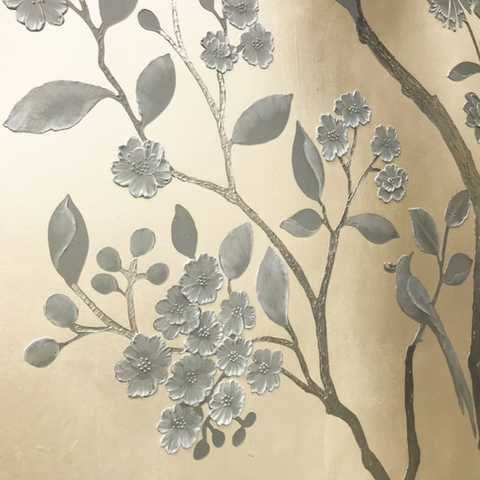Artelier Interview: Maria Apelo Cruz on her Cutting-Edge Plaster Technique
- david
- Jul 31, 2022
- 5 min read
As international art consultants, Artelier specialises in curating art for luxury residential, hospitality, yacht and aviation projects. Artelier's feature wall collection – Artist Walls – presents a collection of artists whose originality of ideas and dedication to their materials makes them true contemporary masters. Through collaborating with Artelier, they have created large-scale custom art commissions that reinvent the concept of the mural for the modern age, pushing the possibilities for feature wall art.
MJ Atelier's innovative, patented technique for creating hand sculpted plaster wall-coverings transcends the usual limitations for site-specific murals. Crack resistant and durable, they are crafted within the studio and shipped worldwide; this allows MJ Atelier to create monumental wall-coverings that are uniquely created for each space and fit corner-to-corner, but are suitable for installation in a vast range of contexts.
In a two-part interview, Curator Alina Young speaks with the Founder and Creative Director of MJ Atelier, Maria Apelo Cruz, to learn more about their innovative methods.

Can you explain the advantages of the plaster technique you developed for MJ Atelier’s wall-coverings?
Traditionally, plaster workers would have to be standing within the project site to create this kind of bas-relief artwork; it is conventionally found on non-bendable substrates like wood and porcelain, because when you roll plaster it cracks. We developed our own technique so that we can work in the studio, complete more, and have more people working on it. We can then roll up to completed wall-covering and ship it worldwide, and we didn’t have to be standing on site for weeks or months creating the work.

A unique quality of your work is that it’s always on canvas, rather than paper – how is that important as a fundamental material choice?
It works well; many people say that most of the time they haven't had a choice – they’d have to have seams every metre or so, or whatever the width of the material. But we are able to run our work at 100ft or more horizontally, and up to 14ft high.
That’s incredibly vast, working to that scale must have brought some technical challenges as you developed your wall-coverings?
It was challenging! We went through a lot of different materials in all aspects and many different formats before we arrived at this one.
Typically, we don't have a design that repeats – everything that we create is uniquely site specific. This means that the client sends us their elevation, we create a design on top of the elevation, and then we create the wall-covering. So, there are no trees cut in corners, branches that have no trunks, and no birds cut in half!
Which makes it very different for the client in comparison to having wallpaper; with that, however intricate the design, you'll always face that problem. This is much more of a modern mural.
It's custom-fit to the environment, so we avoid situations where that happens. When we finalise our boards and renders for the interior designer to approve, they know exactly where every element is and what it looks like before they reveal it.
Is the placement of the design elements something you work with the interior designer on? Do you go to the sites themselves and survey how best to fit the design?
The layout is left up to us, but the person who surveys it is usually the installer. The installer does the field measurements, and sends all the information back to us, and then we create based on that. The interior design team may have some form of drawings or renders. We start from there, and then it gets field measured further down the line. Many of these spaces aren't built at the time of concept.

Do you get a real mix of clients for the plaster work in particular? Considering how customisable it is, and as the work is durable, too?
Yes, our clients are incredibly varied. You can pressure wash the material, you can hit it with a hammer, and it's a tough enough to withstand being outside – we've had it in solid rain and in direct Southern Californian sun. Its durability makes it perfect for hospitality, but also for high-end residential projects.
For such delicately designed wall-coverings, it’s impressive that it’s so hard-wearing!
It's funny, yes – a lot of people are amazed when the see how much pressure the wall-covering can withstand, exactly it doesn’t look like it should.
When we roll it to ship, it doesn’t crack. It can then get installed like any regular wall-covering onsite, anywhere in the world; but you can wash it, scrub it, a chair can hit up against it. You don't need a rail, it won't get dented – it's impact resistant, shatter resistant, and washable.
Was it particularly challenging to develop a plaster technique which could withstand so much? Of course, you'd had very comprehensive training in different traditional techniques, but did you have to do a lot of research and consultation with specialists for this innovation?
Yes, it took years to develop. It's not something that comes about with one breakthrough... it's a process of trial and error. We've done so many trials, testing, observing what works and what doesn't. We saw what made it shrink or crack, and had to move on and find something else. As you can imagine, it took a lot of time to find just the right options.

I loved your peacock-themed staircase mural for the Kips Bay Show House, which was completely different to other MJ Atelier designs. Was that closely developed with another designer?
Yes, we came up with the concept together with Richard Rabel. That was a really unique idea; Richard wanted something that could climb the stairwell, be impactful, and have a certain degree of abstract feeling to it, rather than being totally traditional. Together we wanted to showcase the innovative technique of having not only roll-able plaster, but gilded too.
This wall-covering was also installed as one piece. Another aspect of our work is that we create wall-coverings that fit corner-to-corner, and are completely seamless. So, an entire stairwell could be blind-fitted with one piece of canvas; or, if you’re doing an entire room, it would be just four pieces of canvas for the walls, with one canvas fitting each wall. That's another unique quality that sets us apart.
How quickly can you prepare a complete wall-covering now? The Kips Bay staircase, for example. How long would that take you and your team?
We typically have an 8–12 week lead time, depending on how large the project is. Yet, that particular showcase house – and this is the same for almost everyone that works on showcase houses – you only have a month to come up with concepts, deliver it, and install. So that particular piece took about 2-3 weeks, but of course that took a lot of people, a lot of hands. But almost everything else typically has an 8–12 week lead time, depending on the size of the project.
In contrast to wallpaper, which is limited to one-time usage, can your wall-coverings be repurposed once they have been completed?
In an increasingly environmentally conscious world – we like to tout that our wall-covering falls under sustainable and reusable – you can steam our product from the wall and reuse it in a different environment or repurpose it. We hope that our work finds its way into the new great houses of Europe and the world.

Artelier's art consultancy plays a fundamental role in all artwork commissions, and as the appointed art consultant for projects we bring artists and clients together to achieve forward-thinking and intelligently curated art installations. Discover more about our feature wall services: Artist Walls.
Maria Apelo Cruz and MJ Atelier are featured in Artelier's Artist Walls collection, and have a dedicated page on our website. To read more about Maria Apelo Cruz's own background, visit the second instalment of the interview here.











